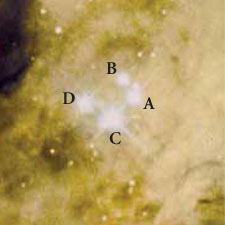
A close-up view of the Trapezium multiple star system with the four bright stars labeled. Click on the image to see the Trapezium within the Orion Nebula.
Courtesy Lick Observatory.
Every 65.4 days the eclipsing binary star Theta1 (q1) Orionis A dims. It's the westernmost of the four bright stars making up the Orion Nebula’s famous Trapezium and is known as component A. It normally shines at magnitude 6.7, just like the Trapezium’s easternmost component, D. The two other bright members of the Trapezium are 5.1-magnitude C, and the eclipsing binary B (magnitude range of 8.0 to 8.6).
The eclipse of A by its close, unseen companion takes roughly 20 hours to complete. At mideclipse (which lasts 2.5 hours) the star is about 1 magnitude fainter than normal. Because of the 65.4-day period, only about a dozen eclipses of this star have been accurately observed since the first one was noticed by German astronomer Eckmar Lohsen on October 11, 1973.
The following table lists the upcoming dates and estimated Universal Times of mideclipse for Theta1 Orionis A. Note that not all will be visible; some take place when Orion is either below the horizon or too close to the Sun to be seen. However, since the entire event lasts some 20 hours, experienced observers may detect the star's fading or brightening even when mideclipse is not visible.
| Minimum of Theta1 Orionis A | |||
| Year | Month | Day | Time (UT) |
| 2005 | February | 15 | 23h 27m |
| 2005 | April | 22 | 9h 49m |
| 2005 | June | 26 | 20h 12m |
| 2005 | August | 31 | 6h 35m |
| 2005 | November | 4 | 16h 57m |
 0
0
Comments
You must be logged in to post a comment.